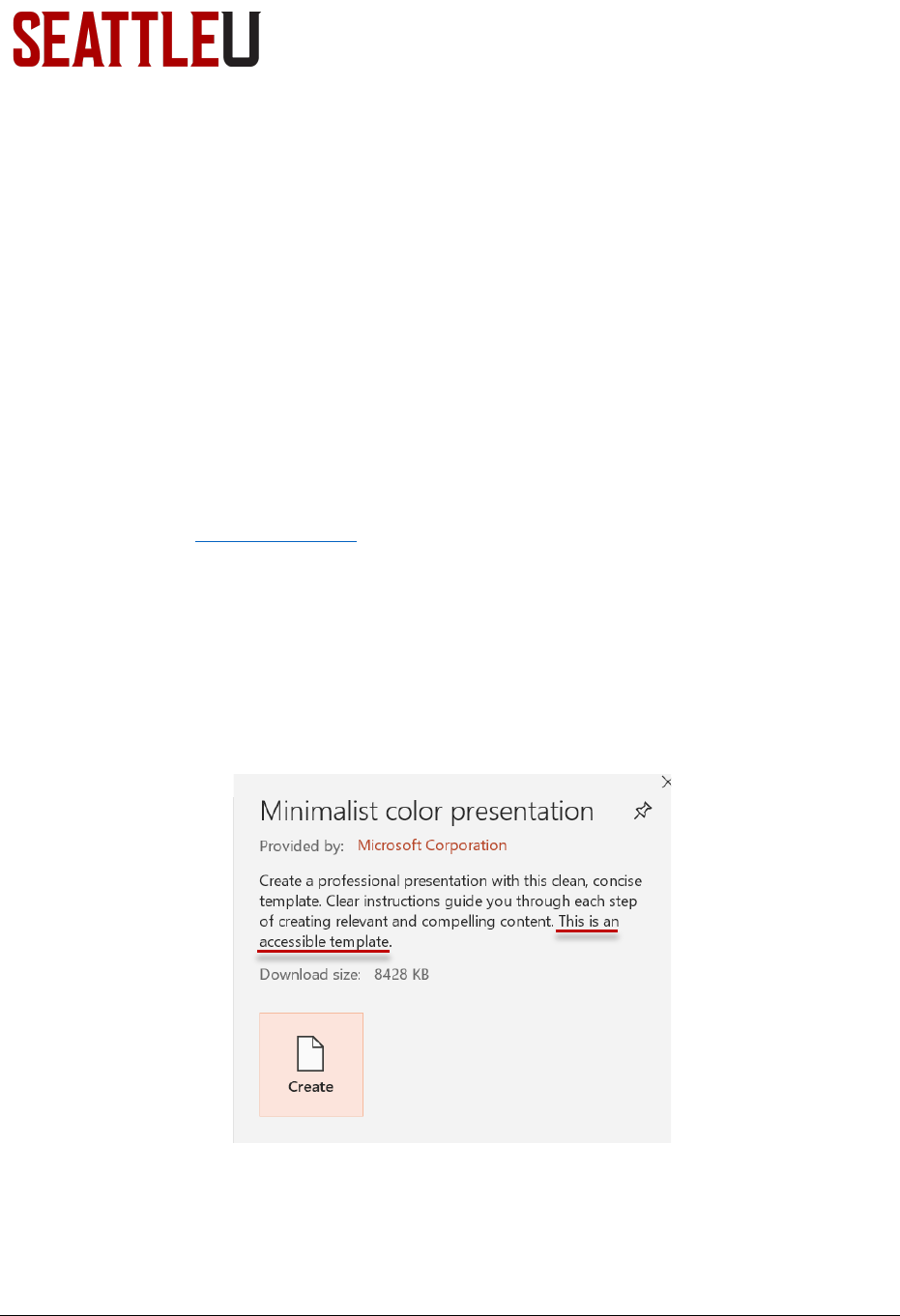
CENTER FOR DIGITAL LEARNING & INNOVATION
Page 1 of 8
Faculty Guide – Accessible MS PowerPoint
Rev. 7/19 MFC
Faculty Guide – Creating Accessible Microsoft
PowerPoint Presentations
Microsoft PowerPoint is one of the most popular tools to use when creating presentations and
lectures. Since PowerPoint is highly visual, users who may rely on assistive technology (i.e.
screen readers, Braille devices, etc.) will need a way to access the content. The following
information includes best practices to ensure your presentation is keeping accessibility in mind.
Using Templates and Themes
It is recommended to use Seattle University branded PowerPoint presentation themes, which
can be found on the MarCom website. An alternative is to use the built-in themes in
PowerPoint since the slides are designed with reading order structures that can be interpreted
by assistive technology.
“This is an accessible template”
To ensure the built-in theme you select is accessible look for, “This is an accessible template” in
the description of the theme. When in doubt, a simple white background with black text is a
great alternative.
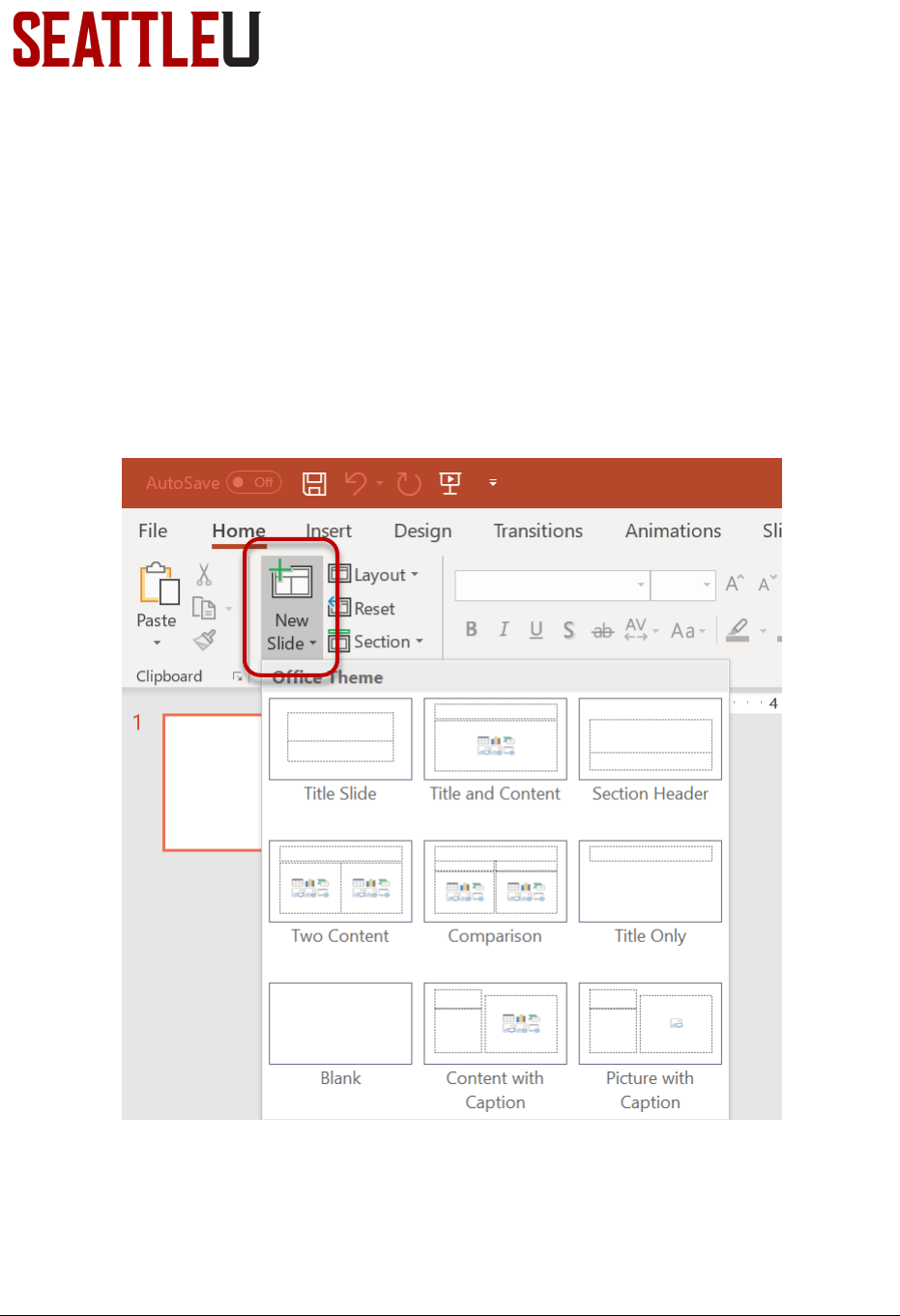
CENTER FOR DIGITAL LEARNING & INNOVATION
Page 2 of 8
Faculty Guide – Accessible MS PowerPoint
Rev. 7/19 MFC
Selecting Slide Layouts
When adding a new slide to your presentation, use an existing layout. For the same reasons as
choosing a themed PowerPoint, slide layouts are built with correct heading structure and
reading order, making it easier for screen readers to read.
1. Under the Home tab select New Slide.
2. A drop down should appear with different slide layouts.
3. Select the layout you would like to use.
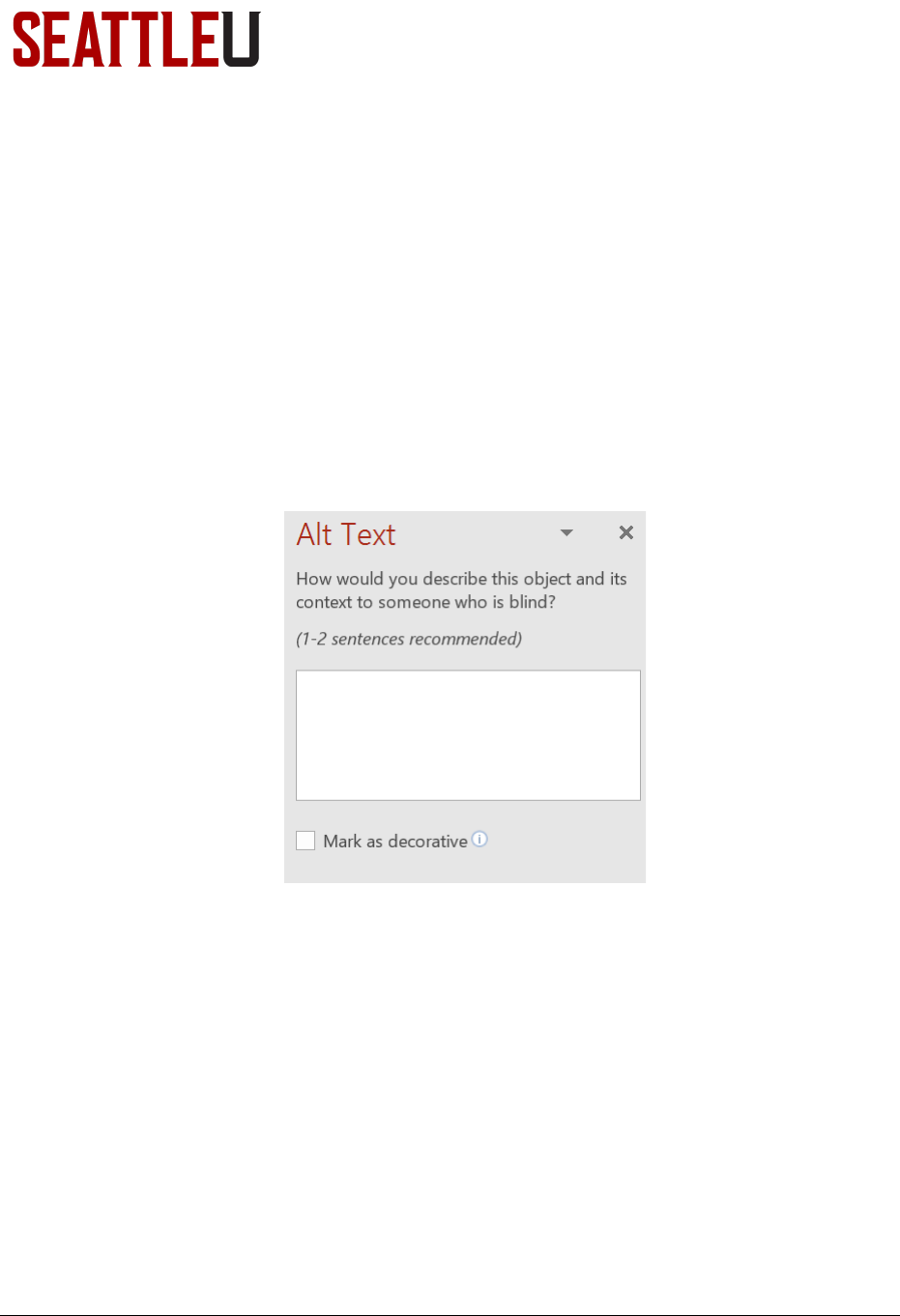
CENTER FOR DIGITAL LEARNING & INNOVATION
Page 3 of 8
Faculty Guide – Accessible MS PowerPoint
Rev. 7/19 MFC
Adding Alternative Text to Images
Images require alternative text so that screen readers can read a description of what the
content is.
PowerPoint 365 and 2019
1. Add image to slide.
2. Right click on image and select Edit Alt Text.
3. Describe what the image is.
4. If it is a decorative image check the Mark as decorative box. Screen readers will skip over
an image if it is decorative.
“Generate a description for me” button
In PowerPoint 365 and 2019 there is an option to allow PowerPoint to auto generate alt text if
you are using Windows. Do not select this option. Most of the auto-generated descriptions are
of poor quality and do not accurately describe the image.
PowerPoint 2016 or older
1. Add image to slide.
2. Right click on image and select Format Picture.
3. Select Size & Properties in the Format Picture sidebar and choose Alt Text.
4. Describe what the image is in the Description field only (leave Title field blank).
5. Images that are decorative cannot be marked as such in PowerPoint 2016 or older
(unless it is part of the slide background).
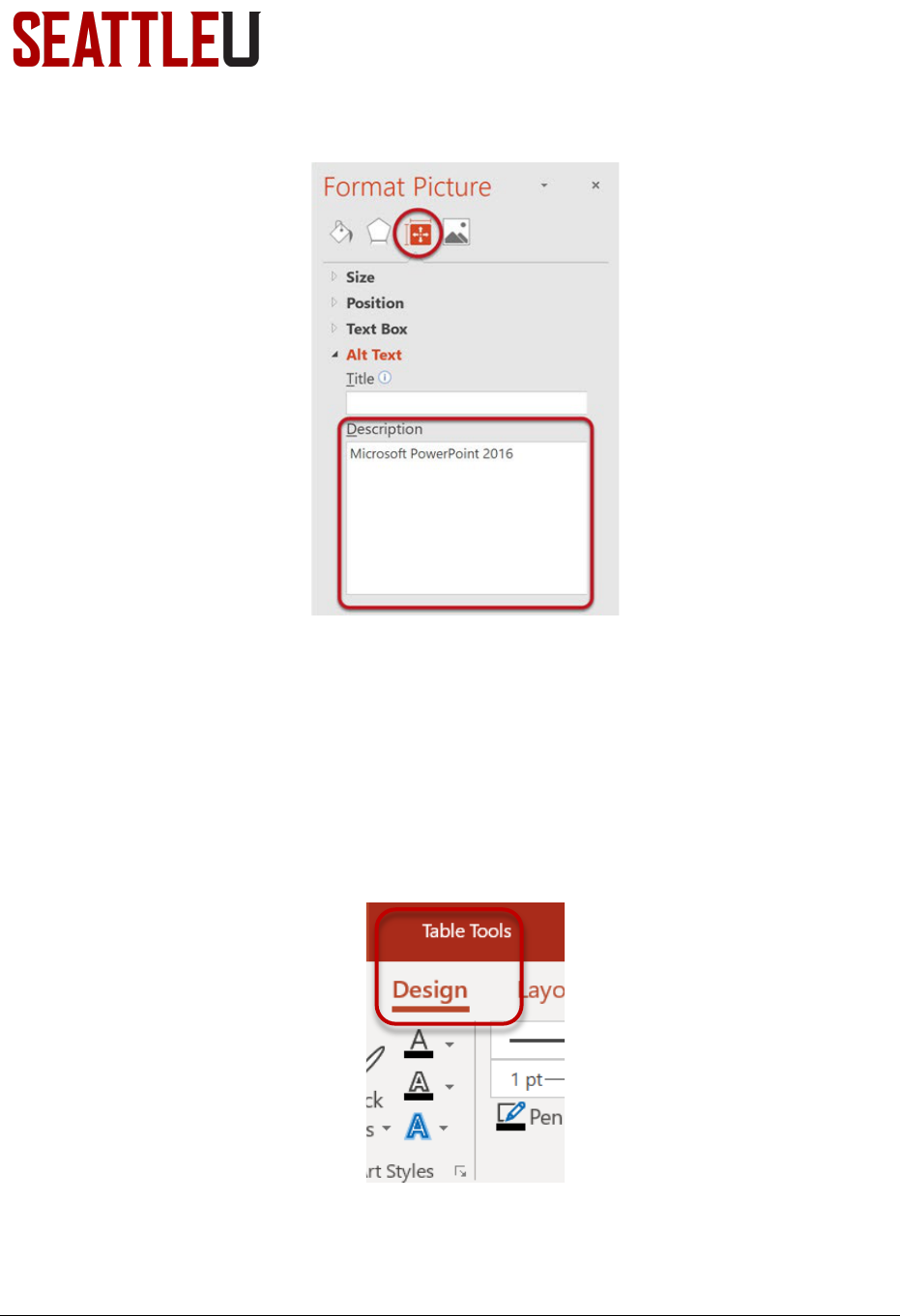
CENTER FOR DIGITAL LEARNING & INNOVATION
Page 4 of 8
Faculty Guide – Accessible MS PowerPoint
Rev. 7/19 MFC
Creating Accessible Tables
Tables need to have properly labeled headers and rows in order for screen readers to keep
track of where a user is within the table.
1. Create a table and click on it.
2. The Table Tools (365 and 2019)/Table Design (2016 or older) ribbon should appear at
the top of the menu bar. Select Design.
3. If the top row and/or first column of the table contains headers, make sure the Header
Row and/or First Column checkboxes are checked.

CENTER FOR DIGITAL LEARNING & INNOVATION
Page 5 of 8
Faculty Guide – Accessible MS PowerPoint
Rev. 7/19 MFC
Merge, Split, and Blank Cells
Keep tables as accessible as possible by not merging cells together, splitting them, or leaving
cells blank. These types of actions on tables can actually confuse a screen reader and cause a
user to miss information or have it read to them incorrectly.
Other Tips
Below are a few other tips to help keep your presentation accessible.
Color Contrast
Use strong color contrast between text and background (i.e. black background/white text or
white background/black text). This helps users with low vision or colorblindness see content
clearly. Additionally, color should not be the only way to convey information. If using color to
emphasis content, include another identifier such as bolding text or adding an asterisk.
Inaccessible: Words in red are important.
Accessible: Words marked with * are important*.
Hyperlinks
Make sure links are properly titled by including descriptive information in the link name. Avoid
copying and pasting a raw URL link or using generic terms such as “click here”.
Inaccessible:
https://webaim.org/techniques/powerpoint/
Click here for PowerPoint techniques.
Accessible: PowerPoint Accessibility
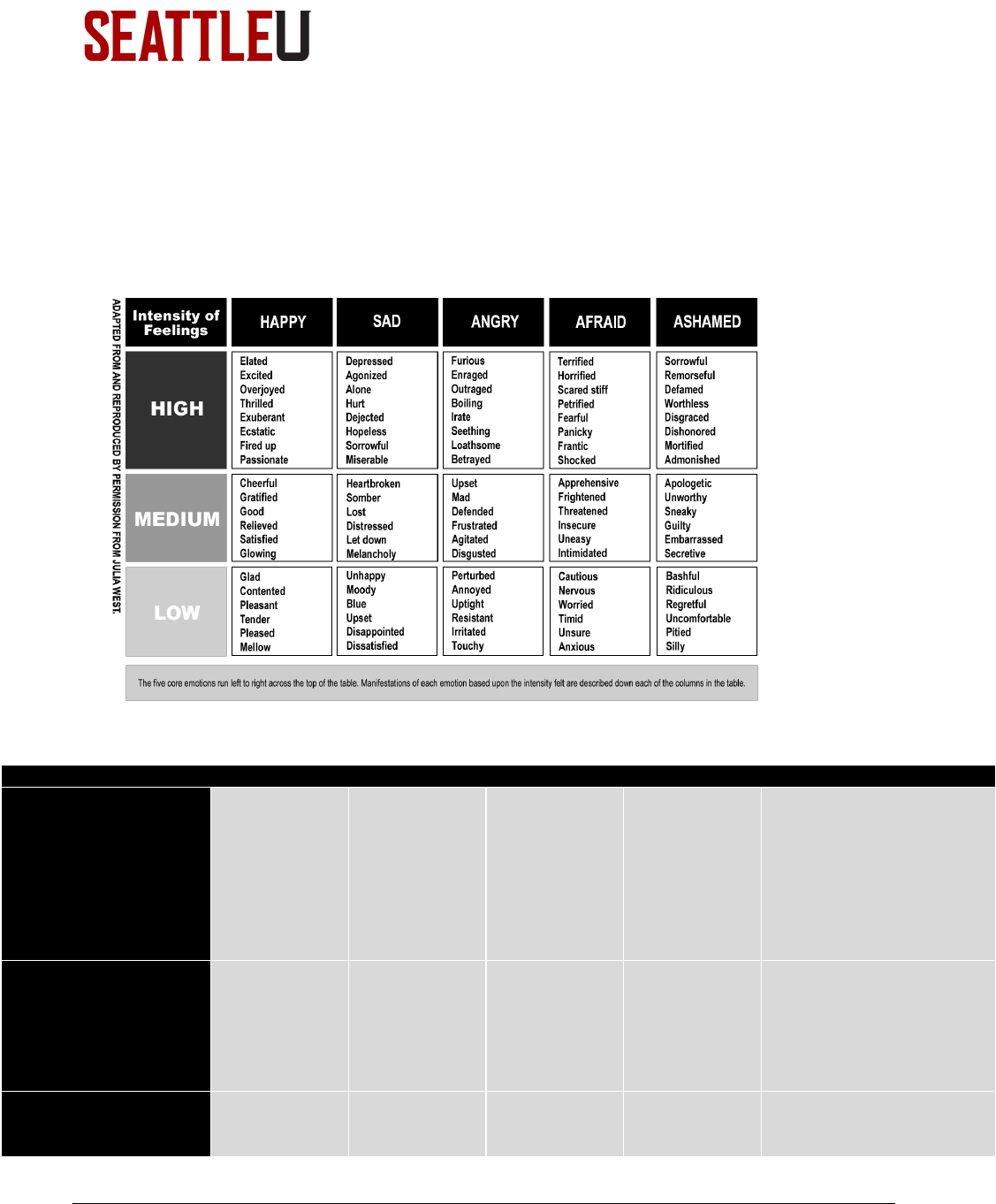
CENTER FOR DIGITAL LEARNING & INNOVATION
Page 6 of 8
Faculty Guide – Accessible MS PowerPoint
Rev. 7/19 MFC
Images of Text/Charts
Images should not consist of text or charts. These types of images will not be properly read by a
screen reader and require extra work to provide descriptions. If you have an image of text or
charts, best practice is to re-create that information directly in PowerPoint.
Inaccessible:
Accessible:
Intensity of Feelings
Happy
Sad
Angry
Afraid
Ashamed
High
Elated
Excited
Overjoyed
Thrilled
Exuberant
Ecstatic
Fired up
Passionate
Depressed
Agonized
Alone
Hurt
Dejected
Hopeless
Sorrowful
Miserable
Furious
Enraged
Outraged
Boiling
Irate
Seething
Loathsome
Betrayed
Terrified
Horrified
Scared stiff
Petrified
Fearful
Panicky
Frantic
Shocked
Sorrowful
Remorseful
Defamed
Worthless
Disgraced
Dishonored
Mortified
Admonished
Medium
Cheerful
Gratified
Good
Relieved
Satisfied
Glowing
Heartbroken
Somber
Lost
Distressed
Let down
Melancholy
Upset
Mad
Defended
Frustrated
Agitated
Disgusted
Apprehensive
Frightened
Threatened
Insecure
Uneasy
Intimidated
Apologetic
Unworthy
Sneaky
Guilty
Embarrassed
Secretive
Low
Glad
Contented
Pleasant
Unhappy
Moody
Blue
Perturbed
Annoyed
Uptight
Cautious
Nervous
Worried
Bashful
Ridiculous
Regretful
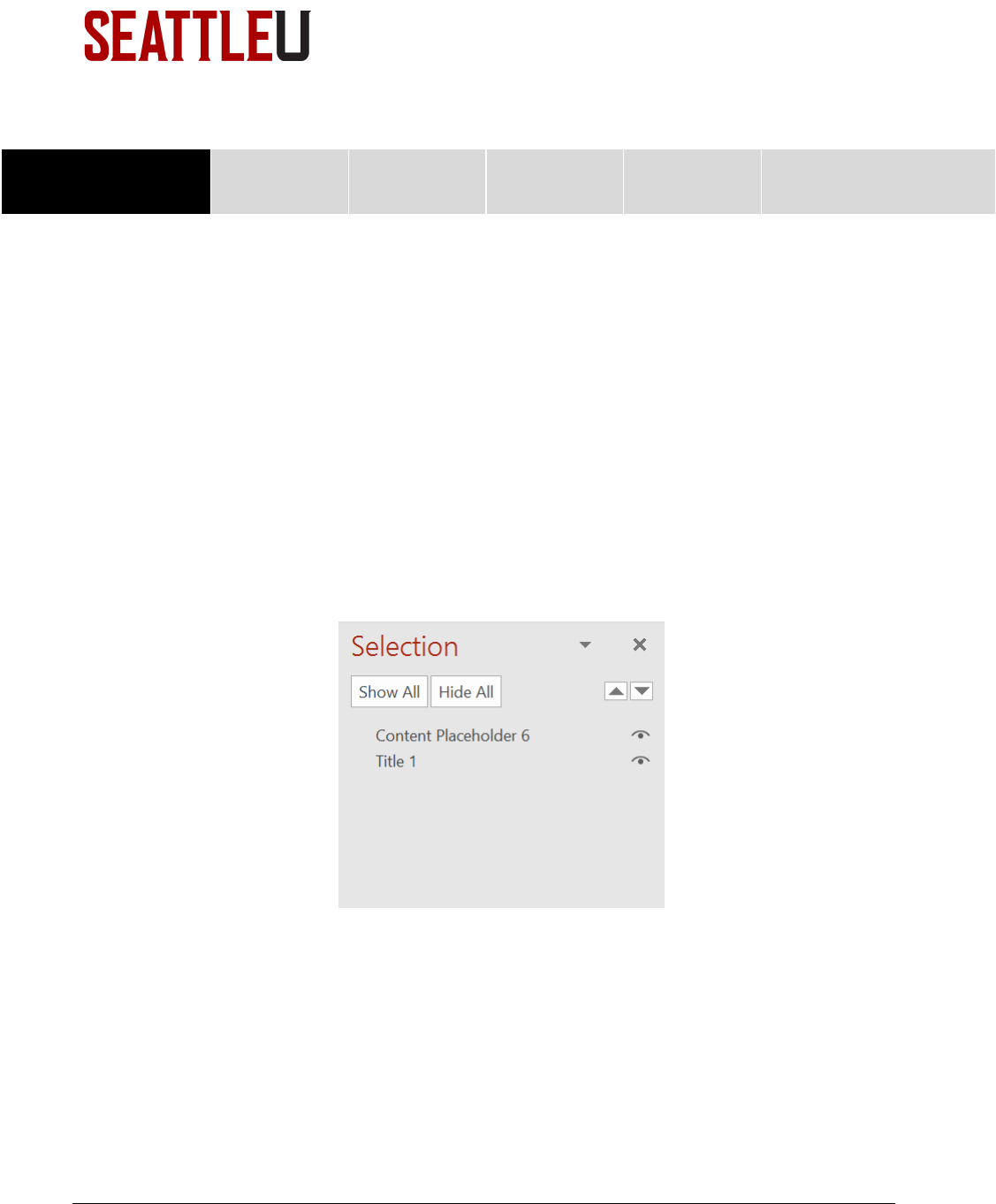
CENTER FOR DIGITAL LEARNING & INNOVATION
Page 7 of 8
Faculty Guide – Accessible MS PowerPoint
Rev. 7/19 MFC
Tender
Pleased
Mellow
Upset
Disappointed
Dissatisfied
Resistant
Irritated
Touchy
Timid
Unsure
Anxious
Uncomfortable
Pitied
Silly
Adapted from and reproduced by permission from Julia West. The five core emotions run left to right across the
top of the table. Manifestations of each emotion based upon the intensity felt are described down each of the
columns in the table.
Reading Order
The order in which slide contents are added can affect the way screen readers read these
elements (even if the order in which they appear is different). You can check the reading order
of each slide to make sure users read the content in the order you intend.
1. In the Home tab choose Select then Selection Pane. (PowerPoint 365 and 2019).
a. For PowerPoint 2016 and older: go to the Home tab and select Arrange then
Selection Pane
2. The reading order for the current slide will appear. Check to see if it is in proper order.
3. Reading order is arranged from bottom to top. Whatever information to be read first
will be at the bottom.
Unique Slide Titles
Different titles for each slide let users with screen readers navigate and skim through the
content quickly. Unique slide titles also provide a clear understanding of which slide they’re on.
As a tip, do not use the same title for multiple slides if there is continued information. Instead,
include helpful information like, Slide Title 1 of 2.
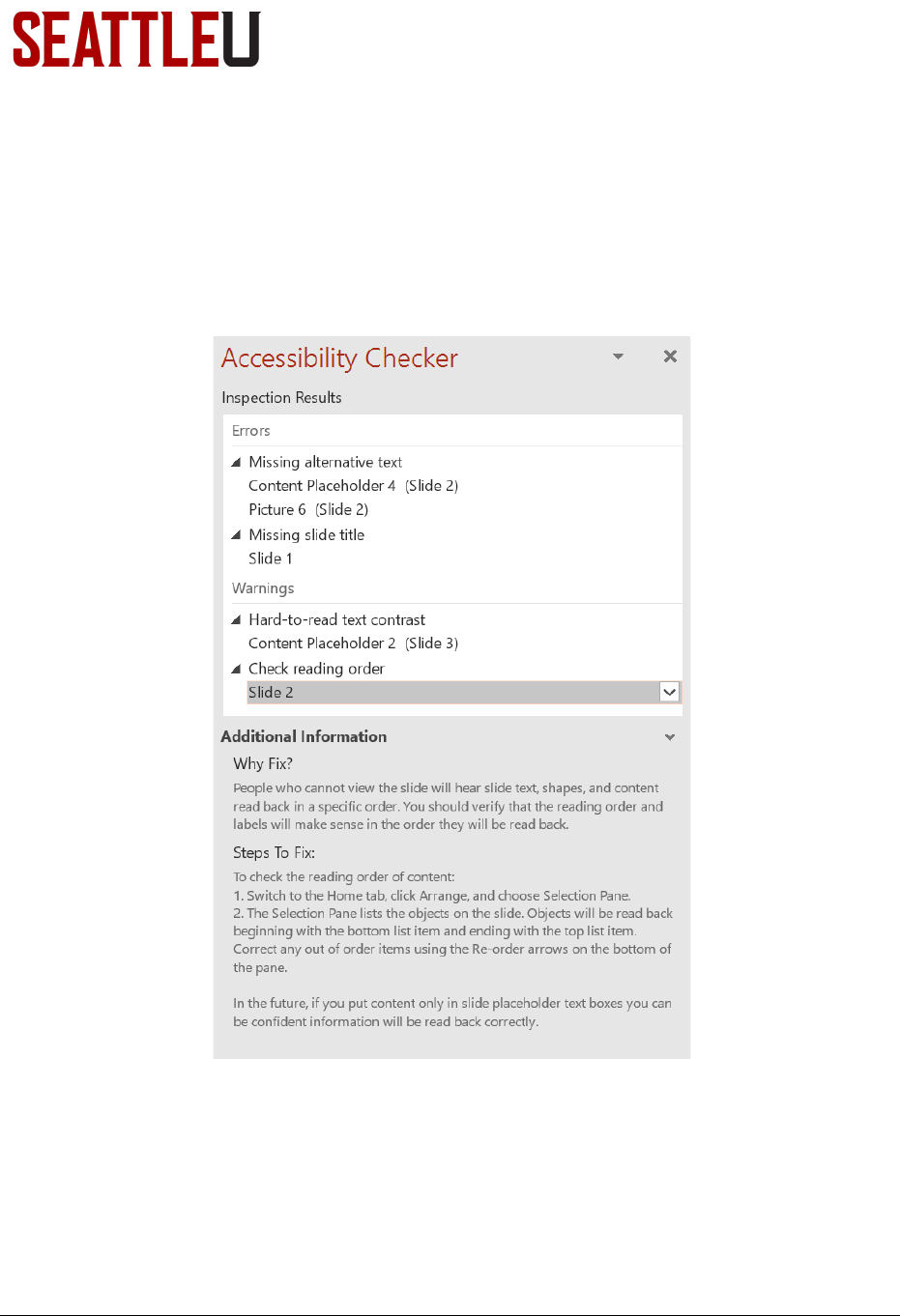
CENTER FOR DIGITAL LEARNING & INNOVATION
Page 8 of 8
Faculty Guide – Accessible MS PowerPoint
Rev. 7/19 MFC
Accessibility Checker
Even after using all the tips and best practices mentioned in this guide, it is recommended to
use the accessibility checker built into PowerPoint. The accessibility checker can help you
identify content in your presentation that is inaccessible as well as offer additional tips on how
to fix remaining issues. Go to the Review tab and select Check Accessibility.
Export to PDF
The best way to share your PowerPoint presentation is by exporting it as a PDF. When a
presentation is exported as a PDF, the accessible structures created in PowerPoint will carry
over into the document. This means all heading structures, alt text, and tables/charts will be
accessible by PDF as well.
